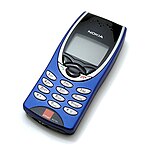Nokia 8210
 |
|
| Manufacturer | Nokia |
|---|---|
| Compatible networks | GSM 900/GSM 1800 |
| Availability by country | Discontinued |
| Successor | Nokia 8310 |
| Form factor | Candybar |
| Dimensions | 101.5 x 44.5 x 17.4 mm, 66 cc |
| Weight | 79 g (Lithium Battery) |
| Memory | No |
| Removable storage | No |
| Battery | Standard, 650 mAh Li-Ion (BLB-2) |
| Display | Monochrome |
| External display | No |
| Rear camera | No |
| Front camera | No |
The Nokia 8210 was, at the time of its release in 1999, the smallest, lightest Nokia mobile phone on the market, thus its selling point was based on its design and customization, with removable Xpress-on covers. Six differently coloured Xpress-on covers are available, as well as many third party ones.
Available in the first quarter of 2001, the Nokia 8250 is a variant of the Nokia 8210 designed for Asian Pacific markets sporting a slightly different design and blue backlight, as well as EGSM (Extended GSM) support. Another GSM version of the Nokia 8210 is the Nokia 8290, designed for the North American market using a single-band GSM-1900.
The Nokia 8260 is a variant of the 8290 designed for IS-136 "TDMA"/AMPS networks in North America. The 8260, weighing 3.4 ounces, is slightly heavier and larger than the 8290 at 2.8 ounces. Unlike the 8290, the 8260 does not feature voice dialing, an infrared port, or officially interchangeable faceplates.
The Nokia 8265 is an updated version of the 8260 sporting an updated design. New features include picture messaging and a white backlight. The Nokia 8265i adds a WAP browser and switches to a blue backlight.
The Nokia 8270 is a related CDMA model with a similar design to the Asian 8250. It operates on the CDMA 1900 frequency. Like the 8250, it features a blue backlight, however, it does not feature an infrared port. In its time, this phone was a great hit with many people. In New Zealand and Australia it was known as "Nokia-Blue" due to the backlight. It had a cult status in the early 2000s in Australia and New Zealand due to its size and backlight.
The phone's memory can store up to 250 names. Alternatively, a SIM card can be used to store names (although memory capacity is specific to each SIM card). The calendar can store up to 50 notes.
The phone has a speed dial feature in which the user can assign a name to each key on the keypad (except 1 which is used for calling voicemail). Voice dialing can also be used by assigning up to 8 voice tags to a name. Dialed, received and missed calls are all registered and calls can be diverted.
The phone uses SMS (Short Message Service) with predictive text input, with support for major European languages. Messages can be up to 160 characters long. Compatible handsets can send and receive picture messages.
...
Wikipedia
